Papers by J. Carlos Alvarez
International Journal of Biomedical Science
Donor cell leukaemia (DCL) is a rare complication of allogenic hematopoietic cell transplantation... more Donor cell leukaemia (DCL) is a rare complication of allogenic hematopoietic cell transplantation (HCT). We report the case of a female patient with acute promyelocytic leukaemia (APL), FAB type M3, who developed acute myeloid leukaemia (AML) type M5 of donor origin 17 years after allogenic bone marrow transplantation (BMT) from her HLA-matched sister. Morphology and immunophenotyping showed differences with the initial leukaemia, and short tandem repeat (STR) analysis confirmed donor-type haematopoiesis. Interphase fluorescence in situ hybridisation (FISH) showed an 11q23 deletion. Given that the latency period between transplant and development of leukaemia was the longest reported to date, we discuss the mechanisms underlying delayed leukaemia onset.

Annals of human biology, Jan 3, 2015
Currently, the Guatemalan population comprises genetically isolated groups due to geographic, lin... more Currently, the Guatemalan population comprises genetically isolated groups due to geographic, linguistic and cultural factors. For example, Mayan groups within the Guatemala population have preserved their own language, culture and religion. These practices have limited genetic admixture and have maintained the genetic identity of Mayan populations. This study is designed to define the genetic structure of the Mayan-Guatemalan groups Kaqchiquel, K'iche', Mam and Q'eqchi' through autosomal short tandem repeat (STR) polymorphisms and to analyse the genetic relationships between them and with other Mayan groups. Fifteen STR polymorphisms were analysed in 200 unrelated donors belonging to the Kaqchiquel (n = 50), K'iche' (n = 50), Mam (n = 50) and Q'eqchi' (n = 50) groups living in Guatemala. Genetic distance, non-metric MDS and AMOVA were used to analyse the genetic relationships between population groups. Within the Mayan population, the STRs D18S51 and...

SpringerPlus, 2013
High-risk prostate cancer is a potentially lethal disease that is increasing in the diagnosis of ... more High-risk prostate cancer is a potentially lethal disease that is increasing in the diagnosis of prostate cancer patients. Compared to other prostate cancer patients (medium or low risk), management, diagnosis and treatment are not as successful among high-risk patients. Because the genetic characterization of prostate cancer patients is increasing, we aimed to determine whether genetic information in one of the primary associated genes, such as RNASEL (2', 5'-oligoadenylate-dependent RNase L), could be used as a biomarker to improve the quality of life and treatment among high-risk patients. The main objective is to identify genetic variants of RNASEL that could be associated with high-risk prostate cancer to improve the clinical managing of these patients. A total of 231 prostate cancer patients were genotyped for 7 variants of RNASEL gene. Clinical information was obtained from medical examinations and genetic analysis (amplification and sequencing 7 variants of RNASEL ge...
HOMO, 2015
Short tandem repeats (STRs) of the combined DNA index system (CODIS) are probably the most employ... more Short tandem repeats (STRs) of the combined DNA index system (CODIS) are probably the most employed markers for human identification purposes. STR databases generated to interpret DNA profiles are also helpful for anthropological purposes. In this work,
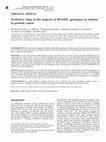
Prostate Cancer and Prostatic Diseases, 2011
BACKGROUND: We would like to compare the different RNASEL genotypes with the stage of the cancer ... more BACKGROUND: We would like to compare the different RNASEL genotypes with the stage of the cancer using parameters such as PSA levels, Gleason score and T-stage, and to develop a clinical protocol for the monitoring of the disease for trying a better evolution of the patient. METHODS: A total of 231 patients with sporadic prostate cancer and 100 of controls were genotyped in RNASEL gene by sequencing the exons 1 and 3. A survey of clinical information was collected by a specialist following the Helsinki protocol. All patients and controls were interviewed by a researcher and signed their informed consent to participation in the study, which was approved by Ethics Committee of the hospital. The genetic information was processed and collected with an ABI PRISM Genetic Analyser 3130 using SeqScape software v.2.6. All the patients were analysed by comparing the genetic and clinical data. w 2-tests, Monte Carlo, Fisher tests and contigency tables were performed using SPSS v.15.0 and ARLEQUIN v.3.5 software on patient population. RESULTS: Significant differences were found only between patients and controls in D541E, R461Q and I97L genotypes, the remainder of the variants did not seem relevant to our population in contrast to other populations, such as north-Caucasians, Afro Americans and Ashkenazi Jews. The genotypes associated with the worst prognoses are G/G in D541E, A/A in R462Q and A/G in I97L. The controls were included in our study to determine an approximation of the genotype in our population compared with the patients, but they did not account for the statistical process. CONCLUSIONS: The genetic profile of patients with this cancer combined with other parameters could be used as a prognosis factor in deciding to give more radical and frequent treatments, depending on personal genotype.
Fertility and Sterility, 1997
Blood typing conventional markers, as well as polymerase chain reaction loci and restriction frag... more Blood typing conventional markers, as well as polymerase chain reaction loci and restriction fragment length polymorphism loci of DNA. Main Outcome Measure(s): Heteropaternal superfecundation was demonstrated after paternity investigation. Result(s): The probability of paternity for twin 1 was 99.9999998%, whereas that for twin 2 was excluded on the basis of the following tests: Fy, Pi, human leukocyte antigen (HLA)-DQAl, DlS80, D17S.5, HBGG, D5S110, D2S44, and DlOS28. Conclusion(s): Dizygous twins can have different biologic fathers, as demonstrated in this case. According to published data, the frequency of twins with different fathers is probably underestimated, at least in small selected populations such as those of paternity suits.
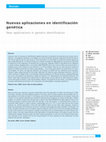
Cuadernos De Medicina Forense, 2010
Cada vez más, los avances en identificación genética permiten la aplicación de estas técnicas a á... more Cada vez más, los avances en identificación genética permiten la aplicación de estas técnicas a áreas muy diferentes. Los progresos científicos y tecnológicos en las herramientas utilizadas en genética forense han permitido nuevas aplicaciones de este campo en otras disciplinas. En este trabajo se pretenden abordar algunas de esas nuevas alternativas. La primera de ellas es la creación de bases de datos genéticas civiles que ha permitido el desarrollo de dos programas de identificación de personas: programa FÉNIX de identificación de cadáveres y restos humanos desaparecidos y la iniciativa DNA-PROKIDS que lucha contra el tráfico de seres humanos y pretende reunir a las víctimas con sus familias. En la última década, cada vez con más frecuencia aparece el análisis del ADN en proyectos de historia, paleontología,… Es en estos casos donde nos encontramos con muestras antiguas. Por tanto, una segunda aplicación es el trabajo con aDNA, del que mostramos varios ejemplos. Gracias a estas nuevas técnicas se han podido identificar los restos de varios personajes históricos, el Zar Nicolás II de Rusia, Cristóbal Colón y sus familiares, Blanca de Navarra y el Príncipe de Viana y el general Miranda; así como la recuperación de especies en peligro de extinción y la caracterización de elementos históricos. Por último, tienen gran importancia sus aplicaciones en biomedicina, ya que cada día es más frecuente la colaboración entre grupos forenses y otras especialidades médicas. Dos ejemplos de ello serían, la caracterización de muestras provenientes de tumores y en la asociación de enfermedades a haplotipos genéticos.
Pathobiology, 2012
analytical processes and to develop policies to make human identity testing more effective. Indee... more analytical processes and to develop policies to make human identity testing more effective. Indeed, DNA typing is integral to resolving a number of serious criminal and civil concerns, such as solving missing person cases and identifying victims of mass disasters and children who may have been victims of human trafficking, and provides information for historical studies. As more refined capabilities are still required, novel approaches are being sought, such as genetic testing by next-generation sequencing, mass spectrometry, chip arrays and pyrosequencing. Single nucleotide polymorphisms offer the potential to analyze severely compromised biological samples, to determine the facial phenotype of decomposed human remains and to predict the bioancestry of individuals, a new focus in analyzing this type of markers.
European Journal of Human Genetics, 2012
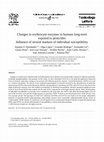
Toxicology Letters, 2005
Changes in erythrocyte δ-aminolevulinic acid dehydratase (ALA-D) have been reported after exposur... more Changes in erythrocyte δ-aminolevulinic acid dehydratase (ALA-D) have been reported after exposure to different pesticides, including organophosphates and paraquat. In this study, we have determined ALA-D in 135 pesticide applicators (sprayers) from an intensive agriculture setting at two periods with different pesticide exposure. Acetylcholinesterase (AChE) was used as a reference biomarker. The effects of the combined polymorphism of enzymes involved in the detoxification of pesticides (paraoxonase (PON1), benzoylcholinesterase (BChE), and glutathione S-transferase (GSTM1 and GSTT1)) on the level of the target erythrocyte enzymes were also studied as biomarkers of individual susceptibility. Sprayers presented significant lower levels of ALA-D and AChE than controls (41.3% and 14.5%, respectively) at the high exposure period. When all biomarkers of individual susceptibility to pesticides were considered at the same time, the GSTT1 null allele determined higher ALA-D and AChE activities at the period of high exposure to pesticides. PON1 R allele in turn determined lower AChE activity at the low exposure period. Null genotype for both GST subclasses (GSTM1 and GSTT1) was found to be the unique independent predictor of pesticide-related symptomatology. Interestingly, sprayers were consistently underrepresented among carriers of “unfavourable” BChE variants. In conclusion, ALA-D appears to be an important biological indicator of pesticide exposure and PON1 and GSTT1 are relevant determinants of susceptibility to chronic pesticide poisoning.
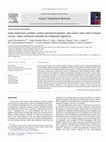
Cancer Treatment Reviews, 2010
During the past decade, several high throughput analytical methods for gene-expression profiling ... more During the past decade, several high throughput analytical methods for gene-expression profiling have been developed. DNA microarrays and multiplex RT-PCR have been applied in the field of breast-cancer research to establish new molecular taxonomic classifications, or a selected group of genes able to predict the prognosis of the patients and/or their response to chemotherapy. This technology provides an opportunity to refine the anti-neoplastic treatment and avoid the currently observed under-and over-treatment of breast-cancer patients. In parallel, high throughput technologies for gene-expression analysis have been applied to research on cancer stem cells (CSCs) and the tumor microenvironment, offering a wider vision of the molecular processes that influence carcinogenic events, disease development, and the response to the treatment of breast-cancer patients. In this report, we briefly revisit the most relevant genomic studies on breast-cancer prognosis and prediction to introduce the latest advances in tumor dormancy, its implications in the clinical outcome of disease-free patients and its connection with CSCs biology and microenvironment influence in the metastatic process. Finally, we have discussed the contribution of the results of these studies to the design of new experimental strategies oriented towards personalized medicine.
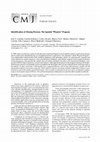
In 1999, Spain was the first country to officially start a National Program to try to identify ca... more In 1999, Spain was the first country to officially start a National Program to try to identify cadavers and human remains which could not be identified by the use of traditional forensic approaches. This attempt is called "Phoenix Program". Two independent mitochondrial DNA (mtDNA) databases were generated, which can automatically compare and match identical or similar sequences. One is the Reference Database, with mtDNA sequences from maternal relatives of missing persons, who provide the samples (buccal swabs) voluntarily; the other is the Questioned Database, comprised of mtDNA data of unknown remains and cadavers. Although the first phase of the program (typing of all unidentified human remains) will probably not be completed until December 2003, positive identifications are being made in the interim. To date, more than 1,200 families have contacted Phoenix, and at least 280 reference samples and 48 questioned evidences have been analyzed. When mtDNA matches are found, another independent analysis is performed as a part of the quality control mechanism. Once a match is confirmed (so far in 6 cases), an attempt is made to analyze short tandem repeat (STR) loci. We call for international collaboration to make this effort valuable worldwide.
Journal of Forensic Sciences, 2005
In order to assess the utility of mtDNA typing for forensic purposes in Uruguay, a population sam... more In order to assess the utility of mtDNA typing for forensic purposes in Uruguay, a population sample of 120 maternally unrelated individuals were amplified and directly sequenced for the HV1 and for the HV2 segments in the control region of the human mtDNA, following previous international recommendations (1).
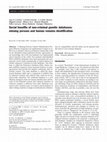
International Journal of Legal Medicine, 2002
A Missing Persons Genetic Identification Program (Phoenix Program) was implemented in Spain in or... more A Missing Persons Genetic Identification Program (Phoenix Program) was implemented in Spain in order to try to identify cadavers and human remains that could not be identified using traditional forensic approaches; to our knowledge, this is the first database ever implemented and in function in the world. Two separate mitochondrial DNA (mtDNA) databases have been generated and comparisons can be made automatically to match identical or similar sequences contained in both databases. One database is called the Reference Database (RD), which contains mtDNA sequences from maternal relatives of missing persons that provide the samples voluntarily after informed consent. The other database is called the Questioned Database (QD) and is comprised of mtDNA data on unknown remains and cadavers that could not be unequivocally identified. The combined database is a civil database designed solely for human identification and because of the informed consent and voluntary donation of reference samples is different from other databases now used to solve criminal cases. It is timely and incumbent on other willing countries to begin an international collaboration so compatibility and full utility can be enjoyed with this kind of non-criminal database.
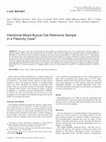
Journal of Forensic Sciences, 2007
We report a case where an alleged father (AF) attempted to substitute someone else's saliva sampl... more We report a case where an alleged father (AF) attempted to substitute someone else's saliva sample for his reference sample in a paternity analysis. Buccal cells were collected from the AF and the child, and DNA analysis was performed using an autosomal STR loci (Identifiler s ). The profile from the AF showed extra peaks in some loci, as well as a much higher ''X'' allele peak relative to the ''Y'' allele peak at the amelogenin locus. After conducting reanalysis by another technician with another set of positive and negative controls, it was concluded that the only source of the mixed profile was by intentional introduction by the AF, at the time of sampling, of some foreign human biological material, most likely saliva from a woman. Owing to the inconclusive results, when the AF was called back to the lab and the peculiar results were explained to him, he admitted that he had introduced into his mouth saliva from another person in an attempt to be excluded as the father of the child. Although tampering with DNA reference samples is not common, some individuals may attempt to contaminate or otherwise adulterate specimens before DNA tests. Personnel responsible for sampling should be aware of this possibility and should try to establish procedures to avoid the problem.
Journal of Forensic Sciences, 2006
POPULATION: Guatemala mestizo.
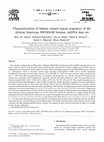
Legal Medicine, 2007
Population data on the hypervariable regions of the mitochondrial DNA (mtDNA) genome are used to ... more Population data on the hypervariable regions of the mitochondrial DNA (mtDNA) genome are used to convey the relative rarity of mtDNA profiles obtained from evidence samples and of profiles used to identify missing persons. In this study, mtDNA profiles of Spanish individuals (n = 312) were analyzed to describe haplogroup distributions and to determine relevant single nucleotide polymorphisms (SNPs) of those haplogroups. All nine common European haplogroups were observed in the sample, and these were divided into subgroups when possible. Haplogroup H was the most common haplogroup. The haplogroups U, J, T, and V were the next most frequent groups, each occurring at a frequency of 6.4% or greater. In addition, African and Asian sequences were present though rare in the samples. The data were compared with and found to be similar to other published data sets. There were 109 SNPs observed in the data set, including 10 positions not previously reported. The most variable sites are consistent with other studies.
Forensic Science International, 1998
A total of 171 Caucasians living in Andalucia (southern Spain) have been typed for nine short tan... more A total of 171 Caucasians living in Andalucia (southern Spain) have been typed for nine short tandem repeat (STR) loci by multiplex PCR amplification using a commercially available kit (Profiler Plus; Perkin-Elmer, Norwalk, CT, USA) and semi-automatic electrophoresis (ABI Prism 377 DNA Sequencer, Applied Biosystems, Foster City, CA, USA). The kit enables typing of the STR loci D3S1358, VWA, FGA, D5S818, D13S317, D7S820, D8S1179, D21S11, and D18S51. All loci, except D7S820, meet Hardy-Weinberg equilibrium. Because of the large number of loci that can be analyzed, the power of discrimination (PD) is greater than 0.99999, and the probability of exclusion (PE) reaches 0.99991 in our population sample.

Uploads
Papers by J. Carlos Alvarez